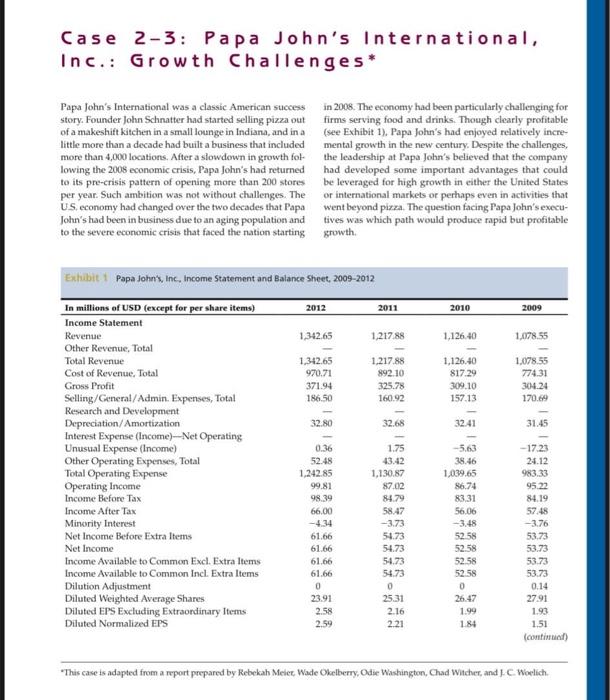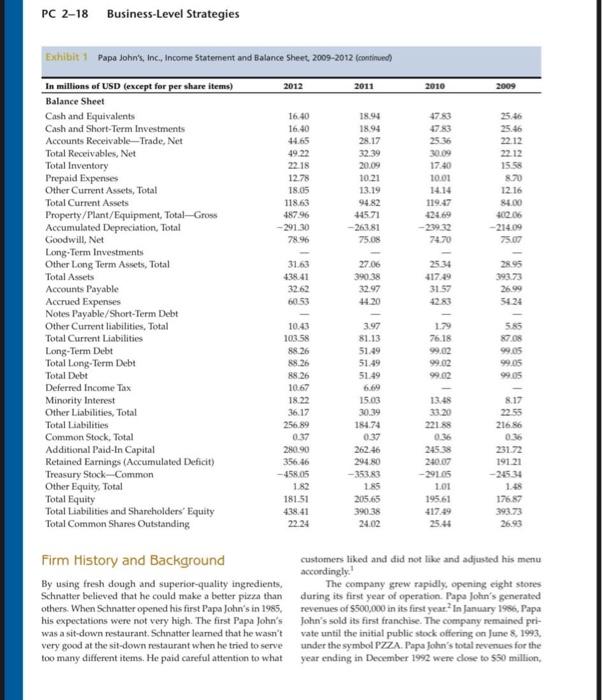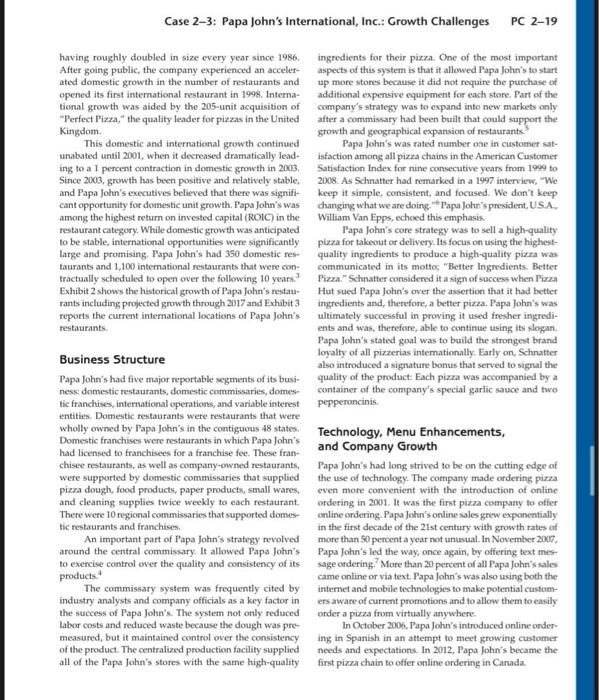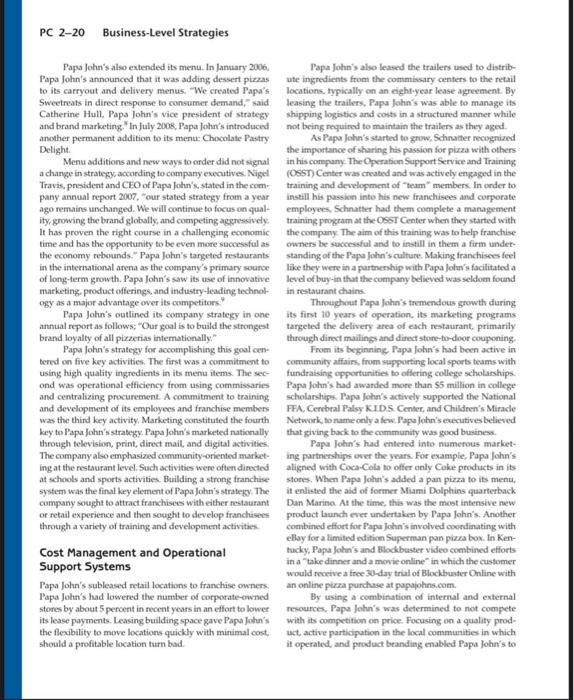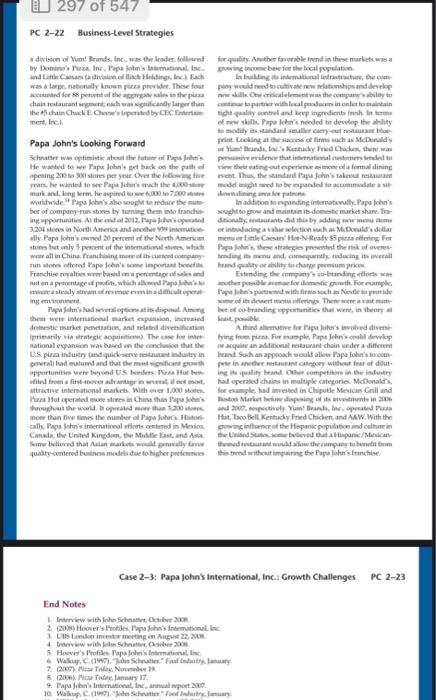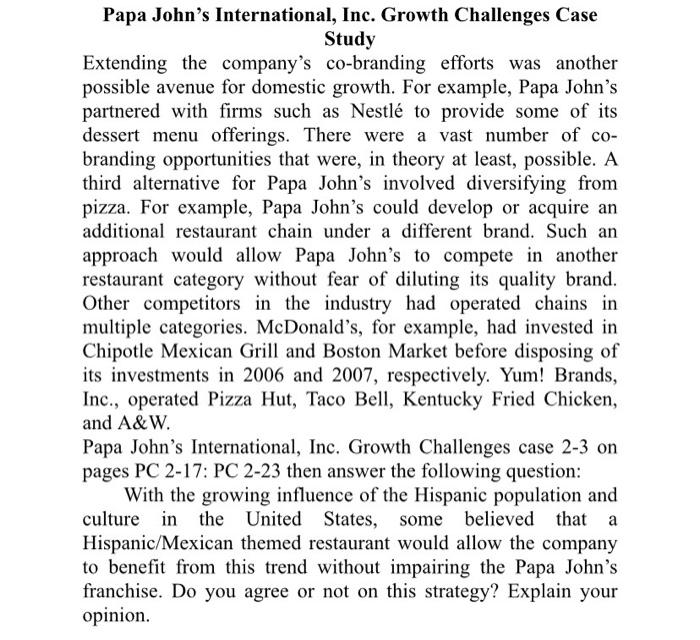Case 2-3: Papa John's International, Inc.: Growth Challenges Papa John's International was a classic American success in 2008. The economy had been particularly challenging for story. Founder John Schnatter had started selling pizza out firms serving food and drinks. Though clearly profitable of a makeshift kitchen in a small lounge in Indiana, and in a (see Exhibit 1), Papa John's had enjoyed relatively increlittle more than a decade had built a business that included mental growth in the new century. Despite the challenges, more than 4,000 locations. After a slowdown in growth for- the leadership at Papa John's believed that the company lowing the 2008 economic crisis, Papa John's had returned had developed some important advantages that could to its pre-crisis pattern of opening more than 200 stores be leveraged for high growth in either the United States per year. Such ambition was not without challenges. The or international markets or perhaps even in activities that US, economy had changed over the two decades that Papa went beyond pizza. The question facing Papa John's execuJohn's had been in business due to an aging population and tives was which path would produce rapid but prositable to the severe economic crisis that faced the nation starting growth. Exhubit 1 Paoa lohn's. Inc. income Statement and Balance Sheet. 2009-2012 "This case is adapted from a meport prepared by Rebekah Melee, Wade Okelberry, Odie Washington, Chad Witaher, and JS. Woelich. PC 2-18 Business-Level Strategies Firm History and Background customers liked and did not like and adjusted his menu By using fresh dough and superior-quality ingredients, accordingly. 3 Schnatter believed that he could make a better pizza than The company grew rapidly, opening eight stores during its first year of operation. Papa John's generated others. When Schnatter opened his first Papa John's in 1985, revenues of $500,000 in its first year 2 In January 1906 , Papa his expectations were not very high. The first Papa John's John's sold its fint franchise. The company nemained priwas a sit-down nestaurant. Schnatter leamed that he wasn't vate until the initial public stock otfering on June 8 , 1993 , very good at the sit-down restaurant when he tried to serve under the symbol PZZA. Papa john's total nevenues for the too many different items. He paid careful attention to what year ending in December 1992 were close to $50 million, Case 2-3: Papa John's International, Inc.: Growth Challenges PC 2-19 having roughly doubled in size every year since 1986. ingredients for their pizza. One of the most important After going public, the company experienced an acceler- aspects of this system is that it allowed Papa John's to start ated domestic growth in the number of restaurants and up more stores because it did not require the purchase of opened its first intemational restaurant in 1998. Interna- additional expensive equipment for each store. Part of the tional growth was aided by the 205-unit acquisition of company's strategy was to expand into new markets only "Perfect Pizza," the quality leader for pizzas in the United after a commissary had been built that could support the Kingdom. This domestic and international growth continued Papa John's was rated number one in customer satunabated until 2001, when it decreased dramatically lead- isfaction among all pizza chains in the American Customer ing to a 1 percent contraction in domestic growth in 2003. Satisfaction Index for nine consecutive years from 1999 to Since 2003, growth has been positive and relatively stable, 2008. As Schnatter had remarked in a 1997 interview, "We and Papa John's executives believed that there was signifi- keep it simple, consistent, and focused. We don't keep cant opportunity for domestic unit growth. Papa John's was thanging what we are doing. " Papa John'spresident, US.A. among the highest return on invested capital (ROIC) in the William Van Epps, echoed this emphasis. restaurant category. While domestic growth was anticipated Papa john's core strategy was to sell a high-quality to be stable, international opportunities were significantly piza for takeout or delivery. Its focus on using the highestlarge and promising. Papa John's had 350 domestic res- quality ingredients to produce a high-quality pizza was taurants and 1,100 intemational restaurants that were con- communicated in its mottog "Better Ingredients. Better tractually scheduled to open over the following 10 years." Pizza." Schnatter considered it asign of success when Pizza Exhibit 2 shows the historical growth of Papa John's restau- Hut sued Papa John's over the assertion that it had better rants including propected growth through 2017 and Exhibit 3 ingredients and, therefore, a better pizaa. Papa john's was reports the current international locations of Papo John's. ultimately successful in proving it used fresher ingredirestaurants. ents and was, therefore, able to continue using its slogan. Papa John's stated goal was to build the strongest brand Business Structure loyalty of all pizzerias intemationally. Early on, Schnatter also introduced a signature bontus that served to signal the Papa John's had five major reportable segments of its busi- quality of the product Each pizza was accompanied by a ness domestic restaurants, domestic commissaries, domes- container of the company's special garlic sauce and two tic franchises, international operations, and variable interest pepperoncinis. entities. Domestic restaurants were restaurants that were wholly awned by Papa John's in the contiguous 48 states. Technology, Menu Enhancements, Domestic franchises were restaurants in which Papa John's and Company Growth had licensed to franchisees for a franchise fee. These fran- chisee restaurants, as well as company-owned restaurants, Papa John's had long strived to be on the cutting edge of were supported by domestic commissaries that supplicd the use of technology. The company made ardering pizza piza dough, food products, paper products, small wares, even more convenient with the introduction of online and cleaning supplies twice weekly to each restaurant. ordering in 2001 . It was the first piza company to otfer There were 10 regional commissaries that supported domes- online ordering. Papa John's online sales grew exponentially tic restaurants and franchises. In the first decade of the 21 st century with growth rates of An important part of Papa John's strategy revolved more than 50 percent a year not untusual. In November 20067 , around the central commissary. It allowed Papa John's Papa John's led the way, once again, by offering text mesto exercise control over the quality and consistency of its. sage ordering. 7 More than 20 percent of all Papa John's sales products. 4 came online or via text. Papa John's was also using both the The commissary system was frequently cited by internet and mobile technologies to make potential customindustry analysts and company officials as a key factor in ers aware of current promotions and to allow them to easily the success of Papa John's. The system not only reduced onder a pizza from virtually anywhere. labor costs and reduced waste because the dough was pre- In October 2006. Papa John's introduced online ondermeasured, but it maintained control over the consistency ing in Spanish in an attempt to meet growing customer of the product. The centralized production facility supplied needs and expectations. In 2012, Papa john's became the all of the Papa John's stores with the same high-quality first pizza chain to offer online ordering in Canada. Papo John's also extended its menu. In January 2006, Papa John's also leased the trailers used to distribPapa John's announced that it was adding dessert pizzas ute ingrefients frum the commissary centers to the retail to its carryout and delivery menus. "We created Papa's. locations, typically on an dight-year lease agreement. By Sweetreats in direct response to consumer demand," said leasing the trailers, Papa John's was able to manage its Catherine Hull, Paps John's vice president of strategy shipping logistics and costs in a structured manner while and brand marketing." In July 2008. Papa Joten's introduced not being required to maintain the trailers as they aged another permanent addition to its menti: Chocolate Pastry As Papu john's started to grow, Schnather recognized Delight. the importanoe of sharing has passion for pirza with others Menu additions and new ways to order did not stgnal in his compuny The Operaficn Support Service and Training a change in strategy, according to company executives. Nigel (OSST) Center was created and was actively engaged in the Travis, president and CEO of Papa John's, stated in the com- training and development of "team" members. In onder to pany annual report 2007, "our stated strategy from a year instill his passion into his new franchisees and corporate ago remains unchanged. We will continue to focus on qual- employees, Schnatter had them complete a management ity, growing the brand globally, and competing aggressively. training program at the OSsI Center when they started with It has proven the right course in a challenging economic the company. The aim of this training was to help franchise time and has the opportunity to be even more successful as owners be saccessual and to instill in them a firm underthe economy rebounds." Papa John's targeted restaurants standing of the Papa John's culture. Making franchisees feel in the international arena as the company's primary sounse like they wene in a partnership with Papa Jolun's facilitated a of long-term growth. Papa John's saw its use of innovative level of buy-in that the company believed wasseldoen found marketing, product offerings, and industry-feading technol- in restaurant chains: ogy as a major advantage over its competitors." Throughout Papa John's tremendous growth during Papa Jotun's outlined its company strategy in one its first 10 years of operation, its marketing programs annual report as follows; "Our goal is to build the strongest targeted the delivery area of each nestaurant, primarily brand loyalty of all pizzerias intemationally." through dinet mailings and dinect stone-to-door couponing. Papa John's strategy foe accomplishing this goal cen- From its beginning. Papa fohn's had been active in tered on five key activities. The first was a commitment to community affairs, frum supporting local sports teams with using high quality ingredients in its menu items. The sec- fundraising opportunities to otiering college scholarships. ond was operational efficiency from using commissaries Papu john's had awanded mote than 55 million in college and centralizing procurement. A commitment to training scholarships. Papa Johan's actively supported the National and developencent of its employees and franchise members FFA, Cenebral Palsy K.IDS. Center, and Children's Mimacle was the thind key activity. Marketing constituted the fourth Network, to name only a few. T'apu John's euecutives believed key to Papa john's strategy. Papa John's marketed nationally that giving back to the community was good busines. through television, print, difect mail, and digital activities. Papa John's had entered into numerous marketThe company also emphasized community-oriented market- ing partnershipo ever the ynars. For exampie, Papa John's ing at the restaurant level. Such activities were often diected aligned with Coca-Cola to offer anly Coke products in its at schools and sports activities. Building a strong franchise stores. When Papa Johrr's added a pan pizza to its menu, system was the final key element of Papa John's strategy. The it enlisted the aid of former Miami Dolphins qaarterback company sought to attract franchises with either nestaurant Dan Marino. At the time, this was the most intensive new of retail experience and then sought to develop franchtsees. product launch ever undertaken by Papa John's. Another through a variety of training and development activities. combined effort for Papu Johan's involved cooedinating with ebiy for a limited edition Superman pan pizca box. In Ken- Cost Management and Operational tucky. Papa John's and Blockbaster video combined efforts Support Systems in a "take dinner and a movie online" in which the customer would receive a tree 30 -day trial of Blockbuster Online with Papa John's subleased netail locations to franchise owners. an online pirra punchase at papajohns.com. Papa John's had lowered the number of corporate-owned By using a combination of internal and external stores by about 5 percent in necent years in an effort to lower. resources, Papa John's was determined to not compete its lease payments. Leasing building space gave Papa Jahn's with its oompetition on price. Focusing on a quality prodthe flexibility to move locations quickly with minimal cost, uct, active participation in the local commumities in which should a profitable location turn bad. it operated, and product beanding enabled Papa john's to hold its own with the other pizza chains. Papa John's had increase in at-home dinner preparation, linked to a dectine worked to create a product branded in such a way that cus: in the percentage of women in the workforce. " tomers came to expect the very best pizza; and they were The large number of restaurant types throughout willing to pay a premium price. Papa John's was committed North America made it unlikely that any firm would gain to holding firm on the quality and prices of its pizzas. a competitive advantage by offering one style or type of cuisine. The one principle that made Papa John's rare in the restaurant industry was its ongoing passion to offer the The Restaurant Industry perfect pizza. Many companies claimed to place quaality at the forefront of their brasiness, but often the commitment to and Pizza Segment quality went no deeper than public relations and was not a core value. The restaurant industry had historically been very attractive Papa John's commitment to the highest-quality ingreto entrepreneurs. Most of these new entrants opened single dients created challenges in managing the supply of the locations. The relatively lows capital requirements made the foods that went into its pirza. The volatility in the price of restaurant business very attractive to small-scale entrepre- cheese had been a major problem for Papa John's. Cheese neurs. Some of these businesses succeeded, but there was material costs contritvute approximately 35 to 40 percent of an interse amotint of competition. There were relatively Papa Jothn's restaurants' food costs. In order to reduce the high fixed costs associated with entering into the restat- cheese price volatility. Papa John's partnered with a third. rant business. These factors caused many of the new busk- party entity formed by franchisees, BJBP Commodities, Inc. nesses to fail. However, for the businesses that succeeded. whose sole purpose was to reduce cheese price volatility the payback on the investment could be quite high. After to domestic system-wide restaurants. This allowed Papa sales reached the break-even point, a nelatively high percent- John's to purchase cheese froen BIBP at a fixed quarterly age of incremental revenues became profit. price. Profits and losses from BibP were then passed on to Restaurant analysts were generally amazed at how Papa John's. 12 successfully Schnatter built Papa John's. Michael Fineman. Rising costs challenged pizza restaurants in multiple a restaurant analyst with Raymond James in St. Peters - areas. Labor costs, as well as food commodity costs, were burg. Forida, stated, "Here's an industry that appears to be rising in the industry. "Although restaurants are experimature and saturated, and here comes john Schnatter with encing cost increases for labor, utitities, and transportahis company Papa John's. He has proven to be a fantastic thon, perhaps no other factor has prompted restaurants to vistonary. 10 increase their prices in 2008 more than food commodity Large nestaurant chains, like Papa john's, were able to cost inflation" (SkePlindustry Surveys [2008]), Rising energy realize economsies of scale that made competition extremely costs had a dual impact on Papa John's and its competitors. difficult for small operators. Some of these advantages Food prices of products related to corn were increasing included punchasing power in negotiating food and pack- even more rapidly because of com's use as an alternative aging supply contracts, as well as real estate purchasing. fuel. Fluctuating in-store utility costs and delivery driver location selection, menu development, and marketing. fuel costs were an ongoing source of concern. In 2007-08, Papa John's operated in the highly competitive pizea such costshad risen dramatically. Another potential threat restaurant market, where the cost of entry was relatively of rising costs stemmed from legislation at the federal level low and product differentiation was difticult. Other pizea as well as many states that mandated a higher minimum chains tried to compete in ways other than Papa John's wage. entsphasis. Some chains focused on being less expensive or Many companies, including Papa John's, engaged in having a broad menu. The meal options available for con- forward pricing to stabilize food costs. Forward pricing is a sumers were increasing both for convenience dining and at- hedging strategy whereby a company negotiates with a suphome consumption. The quality of frozen pizza available at plier to purchase a certain amount of a product at a given grocery stores had improved significantly in recent ycars. A price. Some supply contracts, signed by larger chains, can broader trend was that restaurant and quick-service restau- lock in less volatile food products for an entire year. Some rant dinner occasions were declining which was significant of the products subject to the greatest variability, especially for pizza restaurants such as Papa John's, which gained 70 dairy products, can be locked in only for shorter periods."13 percent of its sakes from dinner orders. Declining restaurant Of the $200-plus-billion restaurant market, the piza and quick-service restaurant dining was attributed to an segment currently held 6.7 percent of the market. Fizza Hut, PC 2-22 Business-Level Strategies by Domina' Texe, Ine, Papu kvten's Inirmatinul, Ine, gnoning innone bue for the bxal pogulation. la buibeng ita indimatinal iedratersichar, the bienmert, Ine.1. Papa John's Looking Forward to micatily its phindart amuller eaery-tut notaurase biuefrint loeding at the masess of firms mach as Meperuld or apeaing 200 to 300 slares per youe. Oher the kelowies fise ewent. Thes, the sanderd thapu fohn's takeoul nestauan ber of compuny tunistoes by tamieg them into franchs sovels goow and maintaim it domestic iurker shane Ira- Fatrmating the iumpany"s ap-tuanding vitions wat ryt etrvacunticnt witened it dewert montu silferings. Theny weee a vast mumtheat were internationd narket exputikan, ingrwated ineie ponible. doetrestic meriet penctasiais, snd nelused divethifiratsen A thind anmative fre faga fihr's involued divenkattrative international inarkets. Wich ewer 1,000 shotes. for esunple, had inveled in Chipute Meaicas Conil and Fime believod that Mulan marhote meald gerinally Lavve Case 2-3: Papa john's international, inc: Growth Challenges PC 2-23 Find Notes I. LIS Limulin incesti moxting en Aupunt 2Z, Mu . 8. Hower's Mrofikes Papa Jochis lntwrational, Ins 6. Dawe Pazar Tolox. Jamary I7. 9. Papa Jital International, tre, annual npoet 3xy. Papa John's International, Inc. Growth Challenges Case Study Extending the company's co-branding efforts was another possible avenue for domestic growth. For example, Papa John's partnered with firms such as Nestl to provide some of its dessert menu offerings. There were a vast number of cobranding opportunities that were, in theory at least, possible. A third alternative for Papa John's involved diversifying from pizza. For example, Papa John's could develop or acquire an additional restaurant chain under a different brand. Such an approach would allow Papa John's to compete in another restaurant category without fear of diluting its quality brand. Other competitors in the industry had operated chains in multiple categories. McDonald's, for example, had invested in Chipotle Mexican Grill and Boston Market before disposing of its investments in 2006 and 2007, respectively. Yum! Brands, Inc., operated Pizza Hut, Taco Bell, Kentucky Fried Chicken, and A\&W. Papa John's International, Inc. Growth Challenges case 2-3 on pages PC 2-17: PC 2-23 then answer the following question: With the growing influence of the Hispanic population and culture in the United States, some believed that a Hispanic/Mexican themed restaurant would allow the company to benefit from this trend without impairing the Papa John's franchise. Do you agree or not on this strategy? Explain your opinion
